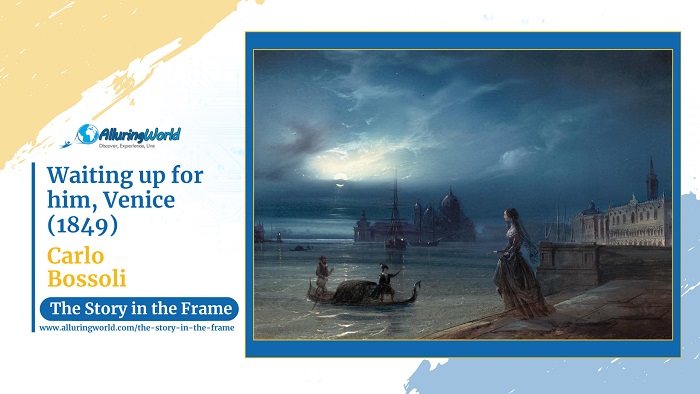Waiting Up for Him, Venice by Carlo Bossoli is a romantic and atmospheric depiction of Venice at night that was painted in 1849 where this evocative work captures a moment of quiet anticipation, as a woman waits by a softly illuminated channel, gazing out into the darkness. The painting exemplifies Bossoli’s talent for blending architectural grandeur with human emotion, creating a scene that is both intimate and cinematic, and his mastery of light and shadow enhances the dramatic tension, drawing the viewer into the subject’s unspoken story.
About the Painter:
Carlo Bossoli (1815–1884) was an Italian-Swiss painter renowned for his cityscapes, historical scenes, and dramatic use of light. His travels across Europe, particularly in Italy, Russia, and England, influenced his work, leading him to develop a distinctive style that combines realism with a romantic sensibility, and often working with gouache and oil, he was especially skilled at capturing architectural details and atmospheric effects. His paintings frequently depicted historical events or emotionally charged moments, making him a sought-after artist of his time.
Inspiration and Reasons Behind the Painting:
The mid-19th century saw a rise in Romanticism, a movement that celebrated emotion, nature, and the mysterious qualities of night and solitude. Venice, with its canals, grand palaces, and moonlit reflections, provided the perfect setting for such themes, so Waiting Up for Him, Venice reflects a narrative of longing, perhaps of love or uncertainty, set against the timeless beauty of the city. Bossoli may have been inspired by the poetry and literature of his era, where themes of anticipation, love, and solitude were frequently explored.
What is Depicted in the Painting:
The painting presents a Venetian nighttime scene, with a woman standing by a Venetian channel, her silhouette illuminated by the moonlight, and as she appears lost in thought, gazing out toward the canal below, waiting for someone to return, the surrounding architecture, with its ornate details and shuttered windows, enhances the sense of place, immersing the viewer in the quiet, melancholic beauty of Venice. The reflections of light on the water, the soft glow of lanterns, and the distant gondolas add depth and movement to the composition, creating a dreamlike atmosphere.
Colors and Techniques:
Bossoli’s color palette in this work is rich in deep blues, warm golds, and soft grays, capturing the interplay of light and shadow. The contrast between the illuminated interior and the darkened cityscape creates a striking visual tension, emphasizing the painting’s emotional depth. His use of delicate brushstrokes and detailed architectural elements enhances the realism of the scene, while the diffused lighting and subtle gradations of color give it an almost ethereal quality. The reflections on the canal add another layer of texture, reinforcing Venice’s reputation as a city of light and water.
Conclusion:
Overall, Waiting Up for Him, Venice is a masterful example of Romantic-era painting, blending architecture, light, and human emotion into a poignant visual narrative, and as Carlo Bossoli’s ability to capture both the grandeur of Venice and the quiet intensity of personal longing makes this piece a timeless exploration of solitude and anticipation. The painting continues to resonate with viewers, offering a glimpse into the universal experience of waiting, longing, and the passage of time in one of the world’s most enchanting cities.

